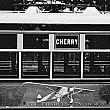
Birth of the Streetcar in Grand Rapids
by Michael Knopf
The first rail coaches in Grand Rapids were horse drawn carriages that ran on tracks. Arriving in 1865, the first horsecar line was a simple two-mile-long route along Monroe and Fulton to Jefferson. Urban centers around the country were developing their first modern modes of public transit around this time. New York was home to the nation’s first horse railways in 1832, while other major cities quickly followed. The industrial giant in the north was awakening and urban cities soon began to crowd as workers filled their new factories. The sudden population increase created a transportation crisis and investors smelled opportunity. A year after the first horseline began in Grand Rapids, on December 7, 1866, the Street Rail Company was officially formed with its hopeful investors putting in more than $50,000 worth of capital.
In order to gain city approval to form their franchises, companies agreed to several costs, which would later have a severe impact. Streetcar companies would pay for the repaving of streets where track was laid, street repair, and snow removal. While the fervent rush to build new track helped to facilitate urban growth, the unplanned and haphazard development was the cause of much troubles for decades to come.
As niche markets arose, investors would typically create new companies to take advantage of the situation. When the Michigan State Fair came to Grand Rapids in 1873 the Division Street Railway Company was formed. Two years later the Reeds Lake Railroad was created which connected downtown Grand Rapids to the popular summer destination Reed Lake in East Grand Rapids. Over the next few years several companies were created, sometimes serving individual areas, often times crossing over each others territory.
This was also the time that the first steam driven “dummy lines” were introduced, beginning in 1875 with the Reed Lake Railroad. Horses had begun to be seen as a liability, illustrated particularly well three years previous in New York when an outbreak of equine distemper disabled eighteen thousand horses. Grand Rapids experimented in a variety of other methods besides steam propulsion, a particularly good example being the cable car system built in 1884 by the Valley City Cable Railway Company. After hearing of the success cable cars had in San Francisco, the company decided to try cable cars at the hill district of the city, eventually building about seven miles of track.
The early years of the streetcar companies were characterized by large investments, high hopes, and poor planning. For years companies had been tearing up new streets to lay track while neglecting their old lines. Because there was no central authority, main streets were served by an overabundance of lines while other sections of the city had no service at all.
In addition the streetcar companies had neglected to properly care for their workers. As 14 to 16 hour days and low wages became common, strikes and riots broke out across the city. Belligerent employees threw stones at passing cars and dynamited tracks. In response companies banned organized labor. The final insult came when the Humane Society complained of abuse to the horses.

 facebook
facebook


